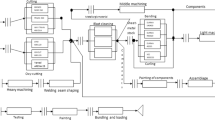Abstract
The service industry is recognized as a central element of modern economies. Services represent an important topic both for practitioners and researchers: although they may contribute substantially to a company’s bottom line, they still lack a methodological support and a systematic study for the design phase. To make service provision profitable in the long term, it is of utmost relevance to balance the excellence in the value channel to the customer with a high efficiency and productivity of the service processes. In this respect, simulation can support companies during their service engineering process by providing a support in the identification of the best scenario, as well as a qualitative and quantitative assessment of the company’s decisions. Nonetheless, no specific service-oriented simulation software is available on the market. Therefore, this chapter aims at comparing two simulation software solutions originally oriented to the manufacturing area. Through a real-case example, we discuss a comparative analysis between two widespread commercial simulation software, evaluating which one is the most suitable to be used in the service contexts.
Access this chapter
Tax calculation will be finalised at checkout
Purchases are for personal use only
Similar content being viewed by others
References
Johnston R, Silvestro R (1990) The determinants of service quality – a customer based approach. In: Proceedings of the 1st international research seminar in service management. Aix en Provence
Johns N (1999) What is this thing called service? Eur J Mark 33(9/10):958–974
Levitt T (1972) Production line approach to service. Harv Bus Rev 50(5):20–30
Berry LL, Parasuraman A (1991) Competing through quality. In marketing services. The Free Press, New York
Bitner MJ (1997) Services marketing: perspectives on service excellence’. J Retail 1(73):3–6
Cook D, Goh C, Chung C (1999) Service typologies: a state of the art survey. Prod Operation Manag 8(3):318–338
Blois KJ (1974) The marketing of services: an approach. Eur J Mark 8(Summer):137–145
Lovelock CH (1983) Classifying services to gain strategic marketing insights. J Mark 47(3)(Summer), 9–20
Berry LL (1980) Service marketing is different. Business, May–June, 24–29
Zeithaml VA, Bitner MJ (1996) Services marketing, McGraw-Hill, New York
Gronroos C (2000) Services management and marketing: a customer relationship approach, 2nd edn. Wiley, New York
Quinn J, Baruch J, Paquette P (1987) Technology in services. Sci Am 257(6):50–58
Lin KJ (2008) The design of an accountability framework for service engineering. In: Proceedings of the 41st Hawaii international conference on system sciences
Bullinger H, Fahnrich K, Meiren T (2003) Service engineering—methodical development of new service products. Int J Prod Econ 85(3):275–287
Banks J (1998) Handbook of simulation: principles, methodology, advances, applications, and practice. Wiley, New York
Bangsow S (2012) Use cases of discrete event simulation appliance and research. Springer-Verlag, Berlin Heidelberg
Laughery KR, Laughery BR, Lovvoll DR, Mcquilkin ML, Wogalter MS (1998) Effects of warnings on responsibility allocation. Psychol Mark 15:687–706
Duckwitz et al (2011) Simulation oh human behavior in knowledge-intensive services, Institute of industrial engineering and ergonomics. RWTH Aachen University, Aachen
Banks (1998) Handbook of simulation: principles, methodology, advances, applications, and practice. Wiley, New York September 14
Gladwin B, Tumay K (1994) Modelling business processes with simulation tools. In: Tew JD, Manivannan S, Sadowski DA, Seila AF (eds) Winter Simulation Conference, Lake Buena Vista, FL, December 11–14. pp. 114–121
Chung AC (2004) Simulation Modeling Handbook: A Practical Approach. Boca Raton, London, New York
Nikoukaran J, Paul RJ (1999) Software selection for simulation in manufacturing: a review. Simul Pract Theory 7(1):1–14
Keeney RL, Raiffa H (1976) Decisions with multiple objectives: preferences and value trade-offs. Wiley, New York
Olson DL (1996) Decision aids for selection problems. Springer, New York
Stewart TJ (1992) A critical survey on the status of multiple criteria decision making theory and practice. OMEGA 20(5/6):569–586
Banks J (1991) Selecting simulation software. In: Proceedings of the 1991 winter simulation conference. Arizona, pp 15–20
Banks J, Aviles E, McLaughlin JR, Yuan RC (1991) The simulator: new member of the simulation family. Interfaces 21(2):76–86
Banks J, Carson JS, Nelson BL (1996) Discrete-event system simulation. Prentice-Hall, Englewood Cliffs
Davis L, Williams G (1994) Evaluation and selecting simulation software using the analytic hierarchy process. Integr Manuf Syst 5(1):23–32
Hlupic V (1997) Simulation software selection using SimSelect. Simulation 69(4):231–239
Nikoukaran J, Paul RJ (1998) Simulation software selection “whys and hows”. Yugosl J of Oper Res 8(1):93–102
Author information
Authors and Affiliations
Corresponding author
Editor information
Editors and Affiliations
Rights and permissions
Copyright information
© 2014 Springer Japan
About this paper
Cite this paper
Pezzotta, G., Pinto, R., Pirola, F., Cavalieri, S. (2014). Evaluation and Assessment of Two Simulation Software for Service Engineering. In: Mochimaru, M., Ueda, K., Takenaka, T. (eds) Serviceology for Services. ICServ 2013. Springer, Tokyo. https://doi.org/10.1007/978-4-431-54816-4_28
Download citation
DOI: https://doi.org/10.1007/978-4-431-54816-4_28
Published:
Publisher Name: Springer, Tokyo
Print ISBN: 978-4-431-54815-7
Online ISBN: 978-4-431-54816-4
eBook Packages: EngineeringEngineering (R0)




